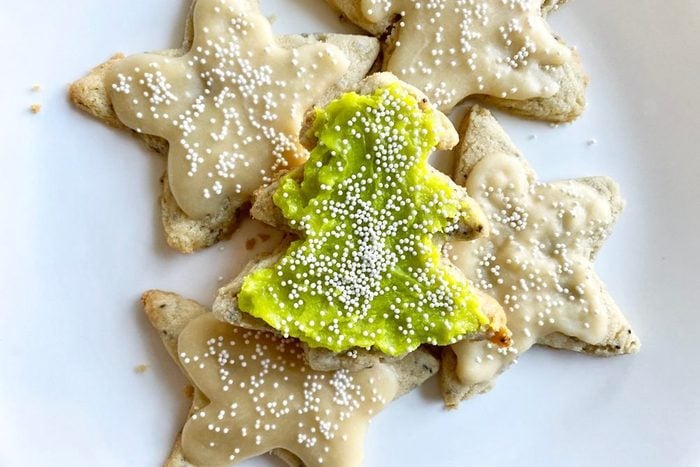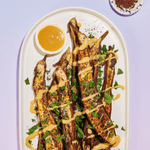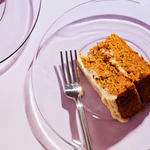The Vegan and Gluten-Free Sugar Cookie This Nutritionist Loves

Dietitian and plant-based diet specialist Cynthia Sass shares her personal vegan and gluten-free sugar cookie recipe, why it's better for you, and how to remain mindful about sugar with holiday treats.
Good news for plant-based and gluten-free eaters: You can have your holiday sugar cookie and eat it, too. Traditional sugar cookies are usually made with animal-based ingredients, namely eggs and butter, as well as refined wheat flour (a.k.a. white flour). Not only does white flour contain gluten—which is found in wheat, rye, and other grains—but it’s been stripped of its fibre and nutrients.
As for sugar, one homemade frosted sugar cookie contains about two teaspoons of the white stuff. Heart & Stroke recommends consuming fewer than 6 teaspoons of sugar a day, due to the link between excess sugar and heart disease, diabetes, stroke, obesity, high blood cholesterol, and cancer.
(Related: Why Gluten-Free is Not a Trendy Diet)
Sugar and mental health
Consuming too much sugar throughout the holiday season can also wreak havoc with your mental health, says Samantha Cassetty, MS, RD, nutrition and wellness expert and co-author of Sugar Shock. “Indulging in special treats during the holidays is one of the joys of the season, but too much can damage emotional well-being, including worsening feelings of loneliness.”
It can also contribute to weight gain, she adds. “Gaining even just a pound or two over the holidays may not sound significant, but there’s a strong chance that, unless you’re diligent about it, you won’t lose it after the holidays,” says Cassetty. “Over time, small gains like this add up, and put you at risk for weight-related problems, like type 2 diabetes.”
(Related: 10 Things That Happen to Your Body When You Stop Eating Sugar)
A word about mindful eating
Vegan, gluten-free versions of traditional holiday goodies can be healthier (read on to learn about the nutritional perks of my personal cookie recipe), but they’re not a green light to overindulge. They still contain sugar. To enjoy any holiday treat in a more sensible way, Cassetty recommends taking a mindful minute to ground yourself when you’re craving something sweet. “This can help you practice portion control and get more enjoyment from any of the goodies you choose,” she says.
As a fellow registered dietitian, I agree. Mindful eating, which Cassetty and I both teach to our private practice clients, helps to curb impulsive eating and binge eating, and has a positive effect on physical activity levels, according to a study published in 2017 in Obesity Research & Clinical Practice.
(Related: How Mindful Eating Can Help You Lose Weight)
The ingredients of a vegan and gluten-free sugar cookie
As for the overall healthfulness of any plant-based, gluten-free dessert, it all comes down to ingredients. When I create a recipe, my goal is to maximize nutrition without sacrificing taste—not always an easy balance to strike. But I feel confident I’ve done it with the recipe below.
Each cookie contains about the same amount of sugar as a traditional sugar cookie (hence, the importance of practicing mindfulness). But, that sweetness is bundled with other nutrient-rich foods that boost each cookie’s overall content of fiber, plant protein, vitamins, minerals, and antioxidants.
Replace egg with chia seeds and water
First, I replaced the egg with a combo of chia seeds and water. One tablespoon of chia seeds provides 16 percent of the daily need for filling fiber, which supports good digestive health. These mighty seeds also contain a wide range of nutrients, including calcium, magnesium, manganese, phosphorus, B vitamins, potassium, zinc, antioxidants, and anti-inflammatory fat.
Swap butter with virgin coconut oil
Instead of butter, I chose virgin coconut oil, which means the oil is unrefined.
A study, published in 2018 in the British Medical Journal, compared the impact of virgin coconut oil, butter, and olive oil, on heart disease risk factors in men and women. After consuming a little under two ounces of one of the fats daily for a month, participants showed different cardiovascular effects. Levels of “bad” LDL (low-density lipoprotein) cholesterol increased in the butter group compared to participants who consumed coconut and olive oils. Virgin coconut oil also increased “good” HDL (high-density lipoprotein) cholesterol levels compared to those who consumed the other fats.
Make the cookies gluten-free
To make the cookies gluten-free, I used Bob’s Red Mill super-fine almond flour. It packs 32 grams of plant protein per cup, along with healthful fat, fibre, calcium, iron, and potassium. I also included whole grain brown rice flour. That provides an additional 12 grams of plant protein per cup, along with bonus fibre and health-protective antioxidants.
Choose pure maple syrup
For the frosting, I opted for pure maple syrup instead of refined sugar. Maple syrup contains dozens of unique antioxidants, according to a study in Pharmaceutical Biology. It’s also rich in manganese, a bone-supporting mineral that’s needed for healing and collagen production.
Recipe: Vegan Gluten-Free Sugar Cookies
These cookies truly mimic their traditional counterparts. Even my hubby was surprised at how closely they resemble the cookies he grew up on. And bonus: since there is no raw egg, you can nibble on the dough before it’s cooked.
Makes about 12 cookies
Ingredients:
Vegan Gluten-Free Sugar Cookies
- 1 tablespoon chia seeds
- 3 tablespoons water
- 1/3 cup coconut oil
- ½ cup cane sugar
- 1 teaspoon vanilla extract
- 1 tablespoon unsweetened oat milk
- 1 cup brown rice flour
- 1 cup almond flour
- ¼ teaspoon baking powder
- 1/8 teaspoon baking soda
- 1/8 teaspoon salt
Coconut Maple Frosting
- ¼ cup coconut butter
- ¼ cup coconut oil
- ¼ cup pure maple syrup
- ½ tablespoon fresh squeezed lemon juice
- All-natural plant-based food coloring (optional)
- Vegan nonpareils sprinkles
Instructions:
- Preheat oven to 375 degrees F. Combine the chia seeds and water and let sit for at least 10 minutes. In a large bowl, cream the coconut oil and sugar and set aside.
- Whisk together the soaked chia, vanilla extract, and oat milk. Add them to the sugar mixture. In a separate bowl, mix together the flours, baking powder, baking soda, and salt. Gradually add the flour mixture to the wet ingredients to form a uniform dough.
- Pat down the dough into a large pancake type shape. Wrap the dough in plastic wrap, and refrigerate for at least two hours. Allow the dough to sit at room temperature for a few minutes.
- On a surface covered with brown rice flour, roll out the dough to a thickness of about a quarter inch. (Note: don’t roll too thin.) Cut with your favorite cookie cutter. Place the cookies at least one inch apart on a baking sheet heavily coated with extra virgin olive oil spray.
- Bake for 10 minutes or until the edges are lightly browned. Allow the cookies to fully cool on a wire rack before carefully removing them from the baking sheet.
For the Coconut Maple Frosting
- Whisk together all ingredients until smooth. Add food coloring if desired. Frost the cookies, immediately decorate with sprinkles—and enjoy! You can also store in a sealed container in the refrigerator.
Next: The One Healthy Apple Recipe You Need to Use Up Leftover Apples




